Nioro, Senegal
Adapting smallholder rain-fed farming systems
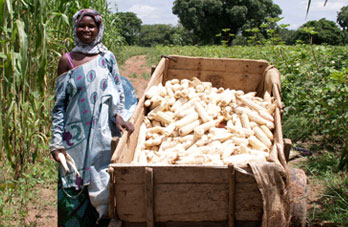
Current Farming System
Smallholder farms
Rain fed
Maize, Millet, Peanut
Low soil fertility
Semi-arid
Semi-humid

CLIMATE 2050s
Increase in temperatures of 1 to 2°C.
Variable rainfall, could decrease by 10% to 20%

Impacts
Maize, as it is grown today, is vulnerable to climate change
Peanut is resistant to climate change under current and future systems
Millet impacts from climate change are variable

VULNERABILITY 2050s
14% to 43% of all farms would be vulnerable to the impacts of climate change
Farms growing only maize would see the most decline in net farm income

Adaptations
75% of current farms would benefit from improved fertilizer, management, and subsidies
For future farms longer crop life cycle benefited maize and millet more than peanut
 Results Overview
Results Overview
In Nioro, Senegal, smallholder rainfed farmers primarily cultivate cereals (millet, maize, and sorghum) and legumes (peanut and cowpea). Crop residues are used to feed livestock, while manure is used to fertilize the cropping system. Recently, farming systems in West Africa have begun to experience climate related impacts to crop production. False starts to the cropping season, untimely cessation of the growing season, and water stresses during the post-flowering and grain filling stages of crop maturation, all have increased in frequency in recent decades. Already, warm days and warm spells have become more frequent in recent decades as maximum and minimum temperatures have increased.
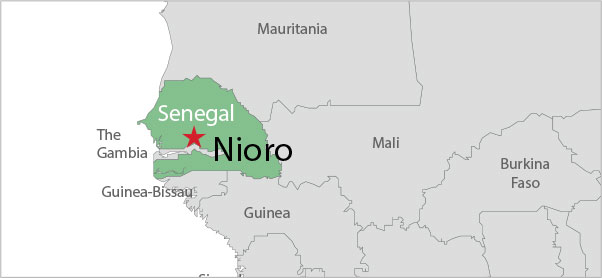
Research site in West Africa
The warming climate has encouraged these recent seasonal shifts and is projected to cause further impacts. Higher temperatures may encourage increased frequency of extreme events and greater rainfall variability. These changes are projected to have impacts on agricultural productivity. High emission projections suggest temperatures could rise by as much as 2.6°C by mid century. The projected precipitation changes are variable, though a decrease of 10-20% is the most likely projection for the region of Nioro.
Climate change will impact each crop and cropping system differently. Currently, peanut production is not vulnerable to climate change and will almost always benefit from warming temperatures. On the other hand, maize is highly vulnerable to changes and will most likely be negatively impacted. The impacts on millet are less clear: different model combinations suggest either slight benefits or declines.
In the future, if production systems and socio-economic conditions are updated to adapt to future developments, climate change may positively impact Nioro farmers. Though maize will continue to suffer from climate change, and millet will remain relatively unaffected, the benefits to peanut production will be significant.
Improving adaptation and farming practices will increase farmer resiliency both today and in the future. Doubling fertilizer input today and adjusting plant density could double cereal yields and may triple maize yields. A relatively simple adaptation, it could be adopted by nearly 3 of 4 smallholder farmers in the region. Additional adaptations include the use of compound fertilizer and an improved seed variety package. 1 in 10 farmers in the region, however, may only adopt these adaptations.
In the future, it will be important to adopt maize and millet varieties with longer crop life cycles. These longer life cycles will assist in eliminating associated negative climate change impacts. Conversely, a longer crop life cycle in peanut will depress yields systematically.
 Farming System
Farming System

Farmer in Senegal
Agricultural systems in Nioro are predominantly smallholder rainfed farms that cultivate a range of cereals (millet, maize, and sorghum) and legumes (peanut and cowpea). Livestock plays a significant role in the functioning of the overall system. Farmers depend on crop residue as feed for livestock and provision of manure as fertilizer for the cropping system. Population pressures have caused fallow land durations to disappear. Very few farmers apply mineral fertilizers. As a result, average yields of cereals and peanut are low. The major constraints to agriculture are low soil fertility, soil erosion, and the lack of ready access to credit and agro-inputs.
In Nioro, annual temperature ranges between 18°C and 44°C. Historical observations demonstrate that maximum temperatures in the region have increased sharply in recent decades while minimum temperatures have increased slightly. Annual precipitation, though highly variable, average 725 mm/year. Between 1990 and 2009, annual precipitation has varied between 418 and 1035mm. Historical observations demonstrate a slight increase in annual rainfall amount.
Based on 2013 national statistics, the Senegalese agricultural sector employs nearly 60 percent of the active population but contributes only 11.2% of GDP. This demonstrates that the agricultural sector, despite being the primary source of labor, is very low in productivity. Though renowned for stability, Senegal is a food-deficit country. Over the last ten years, domestic production has covered between 30% and 65% of annual cereal needs. Imported rice, wheat, and maize have covered the remaining gap (ANSD, 2016).
Income poverty is high in the region though some improvements have occurred in recent history. Efforts and policies over the last decade have lowered the poverty rate from 55.2% in 2001-2002 to 46.7% in 2011. Poverty is more pronounced in rural areas with an incidence of 57.1% compared to 26.1% in Dakar and 41.2% in other cities (PSE, 2014).
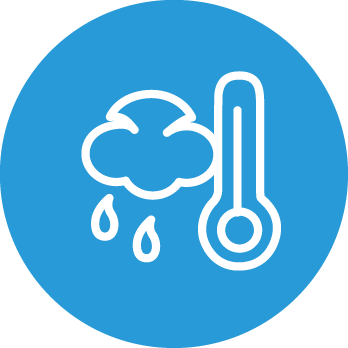 Climate Change Projections
Climate Change Projections

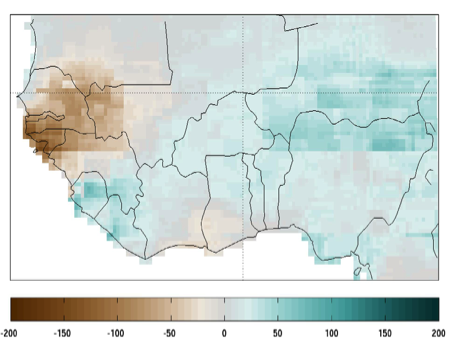
Median changes in June-September growing season (left) temperature (oC) and (right) total precipitation (mm) changes from 29 climate model simulations for Senegal and surrounding countries in West Africa in the 2050s under a high emissions climate change scenario, compared with the 1980-2010 historical period.
Based on the 29 climate models examined in this study, West Africa is projected to experience substantial warming and shifts in precipitation during the critical June-September growing season. In a high emissions scenario, the region is projected to experience increases in temperatures from 1.0-2.5 oC by the 2050s. These impacts will be even greater for Senegal's inland and arid regions.
Rainfall changes are much more uncertain across the models but a common pattern emerges showing drier median conditions in the west (up to a 20% decline in rainfall) and slightly wetter conditions in the east (largely 0 to 10% increases).
AgMIP analyses examined the likelihood of different types of climate changes projected for Senegal, utilizing representative climate models to explore the potential for both wetter and drier conditions as well as varying degrees of plausible warming. These future scenarios are also characterized by higher carbon dioxide concentrations (571 ppm, compared to 360ppm in 1995) that can aid in plant development.
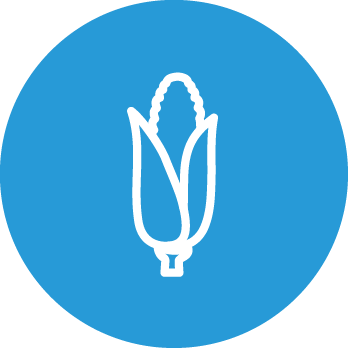 Climate Change Impacts
Climate Change Impacts

Results of crop model projections for 2050s farming systems under moderate and high emissions scenarios. Circles indicate average yield change (%) compared to a future without climate change, and the darker portions of the bar represent the central range of projected changes.
Current System
If current farming systems and cultivation methods are used in the future, climate change will impact the farming system for each crop differently. Peanut will mostly benefit from climate change and will benefit more in higher emissions futures. Peanut will benefit most in a warmer and wetter future climate though may experience reduced yields in drier futures. Maize, which is highly vulnerable to climate change, is projected to experience severe declines in yields. These declines will generally be higher in a higher emissions future. Millet, moderately vulnerable to climate change, is not expected to see large benefits or losses due to climate change; impacts will be minimal.
Future System
When considering future changes in the farming systems, cultivation methods, and socio-economic conditions (discussed below), climate change is projected to have a positive impact on Nioro farm livelihoods. The total impact on crops varies, however, according to future emissions (moderate or high) and in part on soil type and fertilizer application. In general, peanut production will benefit from climate change, especially with improve future production systems and higher input levels. However, some projections suggest dry emissions futures may have negative impacts on yields. Despite input improvements, the general trend shows maize will be negatively impacted. Some regions, however, may benefit slightly from climate change and may produce higher maize yields. Millet remains relatively unaffected, with projected yields changing minimally.
 Vulnerability
Vulnerability
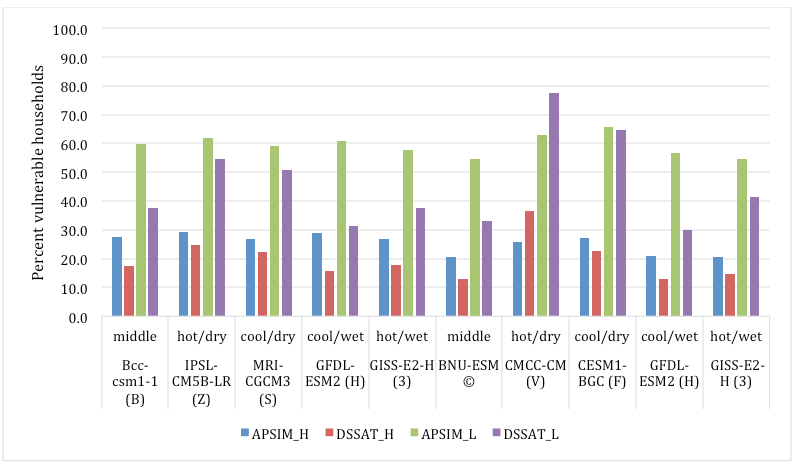
Percent of households that are vulnerable to future conditions in scenarios of the 2050s. Bars represent the green road (first five sets of bars) and gray road (last five sets of bars) of socioeconomic development, with different future prices (H=high L=low), climate scenarios (from the relatively cooler and wetter to the hotter and drier projections) and crop models (DSSAT and APSIM).
Vulnerability, or the percentage of the population likely to be negatively impacted by climate change, is not only dependent on climate impacts but also on economic projections. While yields will be impacted, as discussed above, crop prices will have a significant impact on the percentage of the farming population vulnerable.
Assuming higher prices, the percentage of vulnerable farms is projected to vary between 13% and 37%. Conversely, assuming lower prices, vulnerability increases to range between 55% and 77%. Vulnerability in the lower price situation is especially greater in dry climate scenarios and lower for wet climate scenarios. Overall, farms growing only maize would see the largest decline in net farm income and would be most vulnerable to future climate changes.
Two future scenarios of farm development and emissions were developed to assess future farm vulnerability. These two Representative Agricultural Pathways (RAPs) are described below:
Narrative for Sustainable development RAP - The Green Road
In a sustainable development future, the region develops via a more holistic approach. Inclusive approaches in public policies may be implemented alongside significant development of community initiatives and greater accountability of grassroots organizations. Good agro-ecological practices may become mainstream, including appropriate training of local actors and curriculum development in schools and training institutions. Fertilizer subsidies could increase slightly while the use of organic fertilizer could be especially encouraged.
Though herd sizes may slightly decrease partly because of land fragmentation, livestock productivity may improve as a result of improved feeding and animal health programs. Agro-ecological practices, such as better integration of crop and livestock, and sustainable land management could contribute to a restoration and a gradual improvement of soil fertility. The use of water storage technologies and better management may induce increased availability and access to water.
Decentralization policies may be fully implemented in a context of improved human and social capital. The development of infrastructure, greater access to ICTs and the process of urbanization will put some stress on labor availability, in particular for on farm activities, as new opportunities may become available off the farm.
Narrative for Fossil fuel development RAP - The Grey Road
On the Grey road, population growth and rapid urbanization could lead policymakers to further develop infrastructure and rapidly raise agricultural productivity. The agricultural sector may become a policy priority and may have to respond quickly to increased demand particularly from urban dwellers. Input subsidies, development of road networks and the revitalization of the peanut basin may become key interventions.
These policies and interventions could be fulfilled without proper application of good and environmentally friendly agricultural practices. This could contribute to soil degradation and unsustainable use of water resources. Herd size and livestock productivity may rise as a result of improved political support to the sector, better health protection programs, greater urban demand and the determination of pastoralists to seize these market opportunities.
The development of the digital economy, mechanization of agriculture, and a strong energy demand may enter a powerful influence on rural activities. Household size could decrease along with fragmented farms. Stronger and better road networks could increase employment opportunities outside agriculture, and further encourage a shift away from agriculture.
 Adaptation
Adaptation
What are the benefits of interventions on current agricultural systems?

What are the benefits of climate change adaptations on future agricultural systems?

Several adaptation measures can be implemented to improve crop productivity today. For example, doubling fertilizer input and adjusting plant density will double cereal yields, and may triple maize yields. Results from modeling indicate that at least 3 out of 4 small-holder households are potential adopters of this adaptation. However only 1 in 10 would adopt both a compound fertilizer and an improved variety package. Therefore increasing small-holder use of fertilizers is today more important than improved varieties
Selecting seeds with a longer crop life cycle would be a sufficient adaptation to eliminate negative impacts of climate change on future production of maize and millet, and would produce higher yields than current. Conversely, a longer crop life cycle in peanut depresses yields systematically and cannot be recommended as a valid adaptation.
Two adaptation packages were tested during this study. These adaptation packages are described below.
Adaptation Package 1
In this package, addressing the current low fertilizer input and poor soil fertility is critical. Farmers and government policy will drive this adaptation. An introduction of a fertilizer subsidy will reduce the cost of fertilizer. Improved farmer extension services will educate farmers on appropriate fertilizer management and appropriate plant population density. These education and extension services will optimize returns from fertilizer input.
Adaptation Package 2
In this package, adaptation is driven by both external factors through the introduction of improved seeds with higher genetic potentials and improved crop management at the farmer level. Given that soil fertility is a major yield-limiting factor, increased fertilization will be promoted with the appropriate policies to ensure uptake. The adoption of improved management practices will be championed by improved extension services to farmers, extend credit to farmers to enhance their purchasing powers. This will also involve government subsidies on improved seeds and fertilizer input.
 Stakeholder Engagement
Stakeholder Engagement
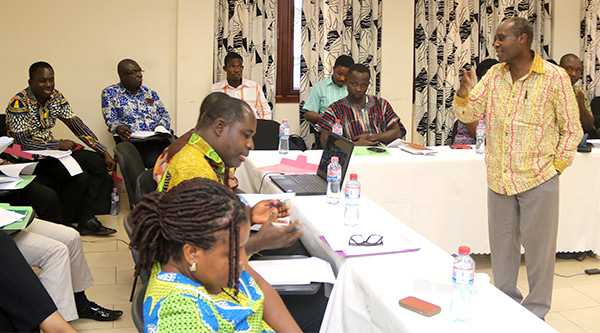
Stakeholder engagement meeting.
The main objectives of stakeholder engagement for the AgMIP project were to incorporate stakeholder points of view in the models, develop future scenarios, and to refine and share AgMIP findings and outputs. Stakeholders were identified after a careful analysis was conducted to target those who had specific interests in the project and those who, through their actions, could make use of results in their decision making contexts and positively affect the outcomes of the project.
AgMIP scientists generated and fine-tuned messages before engaging locally-based stakeholders in Nioro. These meetings occurred several times, and a final stakeholder engagement meeting with national level stakeholders was held in Dakar. This meeting was held with policy makers and members of the National Platform on Climate Change in Senegal attending.
AgMIP key messages, including expected changes in temperature and rainfall, and potential adaptation measures such as heat tolerant and drought resistant crops, were shared with stakeholders. Stakeholders were asked to assist AgMIP with suggestions for solving regional agricultural problems. They recommended developing irrigation schemes, using short duration cultivars, sensitizing the public on climate change, and planting trees and promoting climate education in schools.
These recommendations were important to farmers because of the effects of climate change on their crops and animals. These farmers hoped that the adaptations could go a long way to reduce climate change impacts on their livelihoods
 Learn More
Learn More
This research was made possible by generous support from the UK Department for International Development's UKaid.
This research is a part of the AgMIP West Africa region project; more information is available here.
AgMIP West Africa Team Members
| Dilys S. MacCarthy | Principal Investigator; Crop modeling |
| Sibiry P. Traore | Co-PI; Crop modeling/ Remote sensing |
| Ibrahima Hathie | Co-PI; Socioeconoimc modeling |
| Seydou Traore | Co-PI; Climate modeling |
| Samuel Adiku | Co-PI; Crop modeling/ Remote sensing |
| Mouhamed Ly | Climate modeling |
| Jonathon Anaglo | Stakeholder liaison |
| Joseph K. Clottey | Economist |
| Andree Nenkam | Livestock/ Crop modeling |
| Bright S. Freduah | Crop modeling |
| Eric C. Timpong-Jones | Livestock integration |
| Agali Alhassane | Crop modeling |
| Myriam Adam | Crop/Livestock modeling; ARP |
| F.M. Akinseye | Agro-meteorologist |
| S. Sakho-Jimbira | Junior Ag. Extension |
| Ahmadou Ly | Socioeconomics |
| Stephen Narh | Crop modeling |
Affiliated Institutions
University of Ghana
International Crops Research Institute for the Semi-Arid Tropics (ICRISAT)
Initiative Prospective Agricole et Rurale (IPAR)
AGRHYMET Regional Centre
References
Adiku, S. G. K., Mawunya, F. D., Jones, J. W., and Yangyuoru, M. (2007). "Can ENSO Help in Agricultural Decision Making in Ghana?", in Sivakumar, M.V. K. and Hansen, J. (eds.), Climate Prediction and Agriculture: Advances and Challenges, Springer-Verlag, Berlin, pp. 205–212.
Akinseye, F.M, Adam, M., Agele, S., Hoffman, M., Traore, P.C.S., Whitbread, A.M., 2016. Assessing crop model improvements through comparison of sorghum (sorghum bicolor L. moench) simulation models: a case study of West African varieties. Field Crops Research 201C:19-31.
Akponikpe, P., G´erard, B., Michels, K., and Bielders, C. (2010). Use of the APSIM model in long term simulation to support decision making regarding nitrogen management for pearl millet in the Sahel, Eur. J. Agron., 32, 144–154.
Akponikpe, P., Gérard, B., Michels, K., and C., Bielders. 2010. Use of the APSIM model in long term simulation to support decision making regarding nitrogen management for pearl millet in the Sahel. European Journal of Agronomy 32: 144-154.
Dzotsi, K., Agboh-Noameshie, A., Bontkes, T. E. S., Singh, U., and Dejean, P. (2003). "Using DSSAT to derive optimum combinations of cultivar and sowing dates for maize in Southern Togo", in Bontkes, S. and Wopereis, M. C. S. (eds.), Decision Support Tools for Smallholder Agriculture in Sub-Saharan Africa: A Practical Guide, International Center for Soil Fertility and Agricultural Development, Muscle Shoals, USA.
Dzotsi, K.A., Jones, J.W., Adiku, S.G.K., Naab, J.B., Singh, U., Porter, C.H., and A.J. Gijsman. 2010. Modeling soil and plant phosphorus within DSSAT. Ecological Modelling. 221: 2839–2849
Jones, J.W., Hoogenboom, G., Porter, C. H., Boote, K. J., Batchelor, W. D., Hunt, L. A., Wilkens, P. W., Singh, U., Gijsman, A. J., and Ritchie, J. T. (2003). The DSSAT Cropping System Model, European Journal of Agronomy, 18, 235–265.
Keating, B. A., Carberry, P. S., Hammer, G. L., Probert, M. E., Robertson, M. J., Holzworth, D., Huth, N. I., Hargreaves, J. N. G., Meinke, H., Hochman, Z., Mclean, G., Verburg, K., Snow, V., Dimes, J. P., Silburn, M., Wang, E., Brown, S., Bristow, K. L., Asseng, S., Chapman, S., McCown, R. L., Freebairn, D. M., and Smith, C. J. (2003). An Overview of APSIM, a model designed for farming systems simulation, European Journal of Agronomy, 18, 267–288.
Ly, M., S. B. Traore, A. Alhassane, and B. Sarr, 2013: Evolution of some observed climate extreme s in the Western African Sahel. Weather and Climate Extremes, 1, 19-25, doi:10.1016/j.wace.2013.07.005
MacCarthy, D. S., Adiku, S. G. K., and Yangyuoru, M. (2013). Assessing the potential impact of climate change on maize production in two farming zones of Ghana using the CERES-Maize Model, Ghana Policy Journal Special Issue: Climate Change in Ghana, 5, 29–42.
MacCarthy, D. S., Vlek, P. L.G., Bationo, A., Tabo, R., and Fosu, M. (2010). Modeling nutrient and water productivity of sorghum in smallholder farming systems in a semi-arid region of Ghana, Field Crops Research, 118(3), 251–258.
MacCarthy, D.S., Sommer, R. and P.L.G. Vlek. 2009. Modeling the impacts of contrasting nutrient and residue management practices on grain yield of sorghum (Sorghum bicolor (L.) Moench) in a semi-arid region of Ghana using APSIM. Field Crops Research. 113:2, 105-115.
Naab, J.B., Singh, P., Boote, K.J., Jones, J.W. and K.O. Marfo. 2004. Using the CROPGRO-peanut model to quantify yield gaps of peanut in the Guinean savanna zone of Ghana. Agron J 96:1231–1242
Traore, P. S. C., Kouressy, M., Vaksmann, M., Tabo, R., Maikano, I, Traore, S. B., and Cooper, P. (2007). "Climate Prediction and Agriculture: What is different abut Sudano-Sahelian West Africa", in Sivakumar, M. V. K. and Hansen, J. (eds.), Climate Prediction and Agriculture: Advances and Challenges, Springer-Verlag, Berlin, pp. 189–203.
